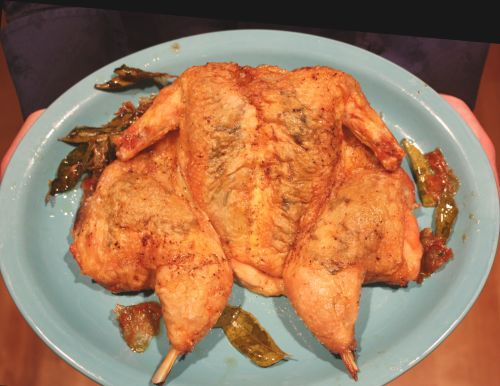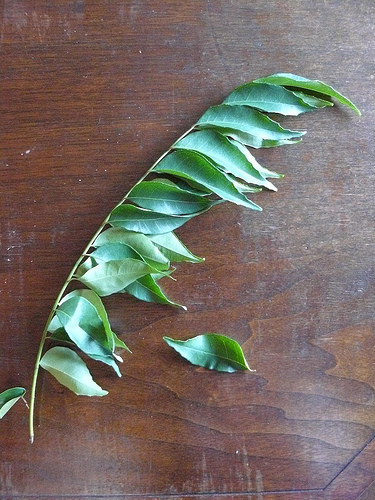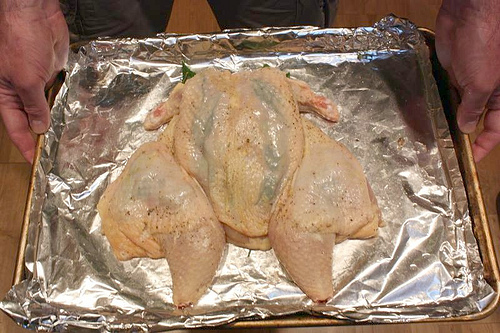
You may have read earlier how my family gave up on eating roast turkey for Thanksgiving. We turned to chickens and game hens for our alternative Thanksgiving menus. Here’s another confession: I hate to turn the bird in a hot oven. I’ll do it when it’s necessary but frankly, when I’ve got a bunch of guests over, perhaps had too much wine to drink, and want to have a relaxing time, I don’t want to flip the bird. The spewing fat and hot oven can ruin things.
My solution to avoid turning the bird is butterflying, which is basically removing the backbone and flattening the bird out. The result looks like an open book.
The advantages of roasting a butterflied bird are these:
- No need to flip the bird: All the skin is facing upward. The butterflied bird bonus is more crisp skin.
- Quick roasting time: It’s splayed out flat so all the parts are done at the same time. The breast doesn’t dry out.
- Great flavor: You can easily get under the skin to season the flesh and tuck herbs in between. Plus herbs put under the bird contribute flavor too. Stuff the stuffing, as well.
- Easy to cut: Tableside carving of a whole bird is a special skill. A butterflied roasted bird sits flat and is easier to cut up in front of a crowd. On the other hand, you can be Asian and cut the bird in the kitchen and present it in large bite-size pieces. Guests using chopsticks may appreciate that!
I've butterflied game hens too and things are just the same, just smaller. You can grill a butterflied bird quite nicely too.
Who does the butterflying?
Ask your butcher – especially if you want a butterflied turkey. He or she will run the bird through the saw. Ask for the backbone to be removed so that you can simmer it with the neck and other parts for the gravy. Do not split the bird through the breast as that will dry it out during cooking.
I often butterfly my own chickens and game hens. It’s not hard. Just get a heavy knife out and if you need guidance, check these step-by-step instructions on butterflying.
Seasoning
At minimum, use salt, pepper and butter. However, this is an opportunity to add extra flavors. I like to use fresh herbs and sometimes rub curry powder under and over the skin. Soy sauce or Maggi Seasoning sauce on the skin will give a beautiful mahogany color. Or, maybe a garlic and cilantro paste like the one used for the Thai grilled chicken.
You can put stuffing between the skin and flesh too and massage the skin to distribute it well. The bird cooks up with very ample looking breasts – more weight lifter than Pamela Anderson.
Last Sunday, I did a practice run of Thanksgiving by roasting a chicken. After butterflying the bird, I went out to the garden to pick some herbs. The Vietnamese ones were spent. The thyme and rosemary were available. Then I noticed that my curry leaf plant needed a trimming so I harvested about 5 sprigs to let them flavor the chicken.

I’d never used curry leaf that way before and it was really nice. The Asian aromatic, sold at South Indian markets in plastic bags, contributed its lemony zing to the flesh and skin. They do not smell like curry powder. The leaves, which resemble delicate bay leaves in appearance, got kind of crisp as they fried in the chicken fat on the baking sheet. I ate a few of the whole leaves.
When you cook a butterflied bird, you can go in whatever direction that your culinary whim takes you. It is delicious and liberating. Experiment. I prefer roast chicken over turkey. If you love turkey more, see the note at the end of this post. Also, this is a great technique that you can do year round!
Recipe
Butterflied Roast Chicken with Curry Leaf
If you’re averse to using butter, use oil. Olive oil, semi-refined or unrefined peanut oil, or a mixture of canola and sesame oil, would all work.
One (4-pound) chicken, butterflied
Salt, kosher preferred
Black pepper, freshly ground preferred
5 fresh sprigs of curry leaf
Softened unsalted butter
1. Position a rack in the middle of the oven, then preheat it to 425F. Line a baking sheet with foil.
2. Meanwhile, season the bird. If the skin is super wet, give it a quick pat down with paper towel. The seasonings will stick better.
First season between the flesh and skin. Use your fingers (trim sharp fingernails!) to separate the skin from the flesh at breast and the leg and thigh areas. Then sprinkle in salt (kosher is great) and black pepper.
Pluck and tuck some leaves underneath the skin. Be a little gentle to avoid poking a hole in the skin, though that won’t ruin things. You won’t use all of the curry leaf. Then put the remaining leaves and sprigs on the baking sheet.
If you want, slide a few nuggets of butter between the skin and flesh too. I suppose you would swipe the curry leaf through the butter to make an easier job of it.

Put the bird on the baking sheet, skin side up. Generously sprinkle with more salt and pepper. Then rub it once more with butter. If you didn’t trim the wing tips, tuck them under.
3. Slide the baking sheet into the oven and let it roast for 45 to 60 minutes, until done. I estimate about 12 minutes per pound for the original weight of the bird. To test for doneness, pierce the thigh with the tip of the knife and the juices should run clear. Wiggle the leg or drummette, there should be just a little resistance. It’s like an easy handshake.
When you’re satisfied, pull the bird from the oven and let it rest for about 10 minutes before cutting and eating.
Butterflied roast turkey
According to Bruce Aidells in the November 2010 issue of Bon Appetit, roast the butterflied turkey at 350F with the rack in the lower third position. He put the stuffing between the skin and flesh and poured a cup of stock into the baking sheet. For a 12- to 14-pound turkey, his roasting time was 2 to 21/2 hours, until the temp at the thickest part of the thigh registered 160F to 165F. For more details see Aidell's recipe for butterflied turkey with fennel, sausage and ricotta stuffing.
Related links:
- How to Butterfly a Chicken
- Chestnuts with Butter and Cilantro Recipe
- Nuts for Chestnuts: Buying, Storing, and Peeling Chestnuts

















Canadian Drugs Online says
Here all these receipes which you can share with is really very fantastic i like it so much. To test for doneness, pierce the thigh with the tip of the knife and the juices should run clear.
momgateway says
curry leaves are so addictive...makes chicken taste so exotic and flavorful
Shuku says
Aren't fried curry leaves just -great-? They use them in fried snacks here - kacang putih, they call them (white nuts) which makes no sense because while there are some nuts in the mix, there are things that aren't. Usual combinations are fried lentils, fried garbanzo beans, broad beans (we have to shell them to eat them but they're sooo good), fried green peas and strips of fried batter/dough. The fried dough especially does have hints of curry leaves in it - in fact, with some vendors, you get the fried leaves in with your packet. Of course, this only happens if you buy these from a vendor at the roadside who sets up everything fresh daily.
Andrea Nguyen says
Shuku: I ADORE curry leaves. They are one of the most splendid gifts to the kitchen. Fried dough with bits of the leaf sounds divine.
I have a small curry leaf tree that we've been carefully tending to for over a year. When I bought it at a South Indian market, the other shoppers asked me what I was going to do with it. It cost roughly 30 USD and was only about 8 inches tall. When I told them I wanted to grow it in a coastal climate, one woman gave me some tips -- put it in the sun!
Nothing happened much for months and then once situated, the little guy grew! Now I've got more curry leaf than I need. What a luxury. Maybe I can open a kacang putih stand in my driveway!
Shuku says
I BET you anything it'd be a HIT. I tried to find you some recipes, and here's the ones I've managed to come up with:
http://paulinedawn.com/street_food/stf070625.asp
The deep-fried lentils I remember are salted, probably given a dose of turmeric, and they had curry leaves in them. I don't think there were any other seasonings. But they are SO GOOD. And yes, curry leaves love the sun! We had one in our house years ago, before my family moved to another housing estate.
You can add them to this particular kacang putih recipe too! They'd taste divine.
Julie says
Curry leaves means La moc mat in Vietnamese. Curry leaves are used to roast duck and silky pigs in Lang Son, Northern Vietnam. The curry fruits are good summer fruits and being used in sour bamboo shoots popularly sold around Lang Son as well. Try roast duck with curry leaves and let me know if it's the best thing in the world you would ever try
Andrea Nguyen says
Julie-- Thanks so much for the info on la moc mat. I didn't know that they were used in Viet cooking so you totally added to the knowledge base! I've got a lot of them growing in the yard...